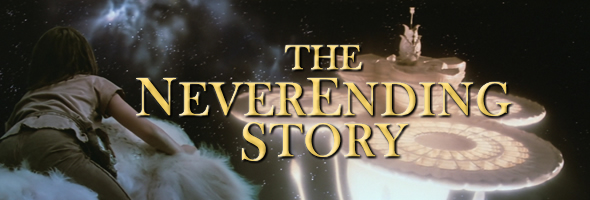

Color, 1984, 101 / 94m.
Directed by Wolfgang Petersen
Starring
Barret Oliver, Noah Hathaway, Gerald McRaney, Alan Oppenheimer, Tami Stronach, Moses Gunn, Thomas Hill
Constantin (Blu-ray & DVD) (Germany R0 HD/PAL), Warner (Blu-ray & DVD) (worldwide R0 HD/NTSC/PAL) / WS (2.35:1) (16:9) / DD5.1
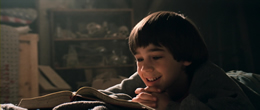
One of the few welcome '80s fantasy films without a trace of Star Wars in it was
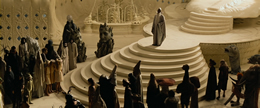 the epic The Neverending Story, the most expensive German production at the time and the ambitious follow up film for director Wolfgang Petersen after his international hit, Das Boot. The source for the film was a sprawling novel by the late writer Michael Ende, who famously went on a crusade against the project (including a failed lawsuit), claiming it distorted the book's meaning. Nevertheless, the film became an instant '80s kid favorite and retains a strong cult following alongside such other films as The Dark Crystal, Legend, and Labyrinth, while also earning a new audience for Ende's book. For obvious reasons, only the first half of the book actually made it to the screen as the entire thing would only been possible in an eight-hour miniseries; however, within these limitations it's a fine film with a somewhat unusual distribution history.
the epic The Neverending Story, the most expensive German production at the time and the ambitious follow up film for director Wolfgang Petersen after his international hit, Das Boot. The source for the film was a sprawling novel by the late writer Michael Ende, who famously went on a crusade against the project (including a failed lawsuit), claiming it distorted the book's meaning. Nevertheless, the film became an instant '80s kid favorite and retains a strong cult following alongside such other films as The Dark Crystal, Legend, and Labyrinth, while also earning a new audience for Ende's book. For obvious reasons, only the first half of the book actually made it to the screen as the entire thing would only been possible in an eight-hour miniseries; however, within these limitations it's a fine film with a somewhat unusual distribution history. The multi layered story is told through the eyes of Bastian (Cocoon's Oliver), a bullied boy still grieving over the death of his mother. One morning he gets chased by bullies and ends up at a bookstore where the mysterious owner (Hill) tantalizes him with a book called The Neverending Story, which takes reader identification to a whole new level. Bastian swipes the book (leaving a note promising to return it) and, after missing the start of a math test at school, hides out in the attic where he begins to read. The story within a story takes place in a fantasy world called Fantasia where a destructive force called the Nothing is swallowing up everything in its path, leaving the survivors to head to the Ivory Tower to seek help from the Childlike Princess (Stronach). She's too ill to help and will not appear, but her councilman (Gunn) enlists the aid of a famous hunter, the young boy Atreyu (Hathaway, aka Boxey from TV's Battlestar Galactica), to undertake a quest to save them all. In the process,
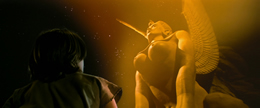 Bastian becomes entangled within the story in ways he could have never anticipated.
Bastian becomes entangled within the story in ways he could have never anticipated. Lavishly mounted and loaded with enough adventures to rank with the best family entertainment, The Neverending Story also features a classic array of creatures highlighted by the poodle-like luckdragon Falkor. The running time stays well under two hours but manages to cram in quite a bit from Ende's book, stumbling only when it tries to
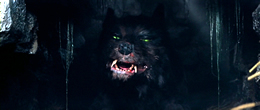 wrap things up with an ill-advised final scene in the real world that accidentally seems to position the whole story as a path to vengeance. Both Oliver and Hathaway make for appealing protagonists (making it a shame they never get to meet like they did in the book), and the music score by Klaus Doldinger (famous from the German jazz group Passport) has remained a fan favorite for good reason. The film went on to inspire two sequels, neither of them remotely as good, as well as a pair of TV series (one live action, the other animated) and several stage productions. Constant threats of a remake have been made as well, which would at least provide big paychecks for a lot of CGI creators.
wrap things up with an ill-advised final scene in the real world that accidentally seems to position the whole story as a path to vengeance. Both Oliver and Hathaway make for appealing protagonists (making it a shame they never get to meet like they did in the book), and the music score by Klaus Doldinger (famous from the German jazz group Passport) has remained a fan favorite for good reason. The film went on to inspire two sequels, neither of them remotely as good, as well as a pair of TV series (one live action, the other animated) and several stage productions. Constant threats of a remake have been made as well, which would at least provide big paychecks for a lot of CGI creators. Not surprisingly, Germany saw the first theatrical release of The Neverending Story in the Spring of 1984 in a version running 102 minutes, featuring a soundtrack comprised entirely of Doldinger's score. International rights holder Warner Bros. made some fairly dramatic alterations before the film was released everywhere else, including numerous small edits throughout the running time which brought it down to 94 minutes. A new, upbeat main titles sequence was added (versus the more somber white and black in the original cut) featuring an insanely catchy theme song by Limahl, former lead singer of Kajagoogoo, which became a pop standard (including a great cover version by Echo Image) and was composed by dance legend Giorgio Moroder. In a move that would be repeated more drastically with Legend the following year, the score was also changed considerably with several new pieces by Moroder adding a poppier sensibility (and weirdly sounding like outtakes from his work on 1982's Cat People). For some reason Warner had no problem reissuing the film in every video format over the years (including scope versions on laserdisc, DVD, and Blu-ray) but never felt the urge to create a special edition, perhaps due to sore feelings over their ill-fated final teaming with Petersen on Poseidon. In fact, the Warner Blu-ray (available in most major territories) doesn't even contain a trailer; you just get a reasonably solid HD transfer (from a somewhat dingy but crisp print) with audio options in English, French and Spanish, plus a slew of additional subtitle options.
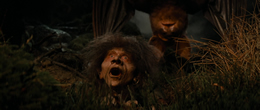 Meanwhile in Germany, the substantially longer version was released with the (very good) German dub and no English-friendly options on VHS and DVD, including a double-disc set pairing it up with the international cut. However, fans were upset in 2011 when a Blu-ray was released from Universum containing the 94-minute version with the German and English soundtracks, and it quickly went out circulation. Finally in September of 2013, the second German Blu-ray from its original distributor, Constantin, proved to be a welcome surprise as it contained the original longer version in both German and English (in DTS-HD 5.1 and Dolby Digital 2.0 mixes) with the complete original Doldinger score intact on both. (And it's region free, too!)
Meanwhile in Germany, the substantially longer version was released with the (very good) German dub and no English-friendly options on VHS and DVD, including a double-disc set pairing it up with the international cut. However, fans were upset in 2011 when a Blu-ray was released from Universum containing the 94-minute version with the German and English soundtracks, and it quickly went out circulation. Finally in September of 2013, the second German Blu-ray from its original distributor, Constantin, proved to be a welcome surprise as it contained the original longer version in both German and English (in DTS-HD 5.1 and Dolby Digital 2.0 mixes) with the complete original Doldinger score intact on both. (And it's region free, too!) 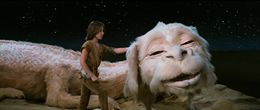 Now that we have the chance to evaluate an English-language version, how does it compare? Well, the cuts themselves are far too numerous to list here (though the IMDb has a pretty good rundown), but the main difference (apart from the credits and soundtrack) is the much stronger melancholy feeling weaving throughout the film, including a more lingering emphasis on Bastian's sadness at the beginning and, in the most obvious addition, a greatly extended version of the Swamps of Sadness scene which already left many young viewers devastated in its shorter form. Both versions have their merits, of course (especially depending on how much one likes the added Moroder music), and while it's jarring to lose the Limahl song in its more appropriate placement over the end credits here, this may be the one fans go back to more often.
Now that we have the chance to evaluate an English-language version, how does it compare? Well, the cuts themselves are far too numerous to list here (though the IMDb has a pretty good rundown), but the main difference (apart from the credits and soundtrack) is the much stronger melancholy feeling weaving throughout the film, including a more lingering emphasis on Bastian's sadness at the beginning and, in the most obvious addition, a greatly extended version of the Swamps of Sadness scene which already left many young viewers devastated in its shorter form. Both versions have their merits, of course (especially depending on how much one likes the added Moroder music), and while it's jarring to lose the Limahl song in its more appropriate placement over the end credits here, this may be the one fans go back to more often. Apparently the film elements for the German edition were left in substandard condition and almost lost, and with that in mind, the restoration here is a welcome one indeed with one caveat. The colors are by far the most impressive of any video transfer of the film, and it looks quite a bit fresher and brighter than the Warner disc with a notable amount of extra information on all four sides of the frame as well. However, it's worth noting that (for reasons demonstrated in the making-of featurette), there's been a significant application of digital noise reduction, meaning some textures aren't as detailed or film-like as they could have been. (For example, compare this shot from the Warner Blu-ray with this one from the German disc.) Due to the film source, the opening titles, the cover of the title book, and Bastian's note left for the bookseller are all in German, which won't be an issue for anyone even slightly familiar with the film. Reportedly this same master was also used for the double-disc Blu-ray set released in Japan at the same time (which contains both cuts), though that isn't available for comparison. As for extras, you get the vintage 20-minute behind-the-scenes featurette prepared for German TV broadcast with most of the German principals being interviewed along with behind-the-scenes footage and a few brief comments in English. (The much longer documentary "60 Millionen für Phantasien" has yet to be included, though you can watch it with English subtitles on YouTube.) A 10-minute restoration featurette shows the extensive digital work performed to salvage the film elements, which look extremely gritty. It's evident why so much grain removal was performed, though a lighter touch might have been a wiser choice. Finally you get six minutes of storyboard comparisons and the wonderfully kitschy Limahl music video, so at least you can still get your fix of that theme song somewhere on the disc.
Reviewed on October 8, 2013.
![]()